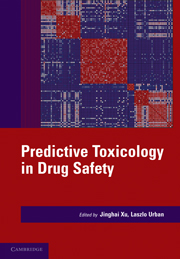Book contents
- Frontmatter
- Contents
- Contributors
- Prologue – Predictive toxicology: a new chapter in drug safety evaluation
- PREDICTIVE TOXICOLOGY IN DRUG SAFETY
- I SPECIFIC AREAS OF PREDICTIVE TOXICOLOGY
- II INTEGRATED APPROACHES OF PREDICTIVE TOXICOLOGY
- 10 Integrated approaches to lead optimization: improving the therapeutic index
- 11 Predictive toxicology approaches for small molecule oncology drugs
- 12 Mechanism-based toxicity studies for drug development
- 13 Fish embryos as alternative models for drug safety evaluation
- 14 The role of genetically modified mouse models in predictive toxicology
- 15 Toxicogenomic and pathway analysis
- 16 Drug safety biomarkers
- 17 Application of TK/PD modeling in predicting dose-limiting toxicity
- 18 Prediction of therapeutic index of antibody-based therapeutics: mathematical modeling approaches
- 19 Vaccine toxicology: nonclinical predictive strategies
- Epilogue
- Index
- Plate section
- References
17 - Application of TK/PD modeling in predicting dose-limiting toxicity
from II - INTEGRATED APPROACHES OF PREDICTIVE TOXICOLOGY
Published online by Cambridge University Press: 06 December 2010
- Frontmatter
- Contents
- Contributors
- Prologue – Predictive toxicology: a new chapter in drug safety evaluation
- PREDICTIVE TOXICOLOGY IN DRUG SAFETY
- I SPECIFIC AREAS OF PREDICTIVE TOXICOLOGY
- II INTEGRATED APPROACHES OF PREDICTIVE TOXICOLOGY
- 10 Integrated approaches to lead optimization: improving the therapeutic index
- 11 Predictive toxicology approaches for small molecule oncology drugs
- 12 Mechanism-based toxicity studies for drug development
- 13 Fish embryos as alternative models for drug safety evaluation
- 14 The role of genetically modified mouse models in predictive toxicology
- 15 Toxicogenomic and pathway analysis
- 16 Drug safety biomarkers
- 17 Application of TK/PD modeling in predicting dose-limiting toxicity
- 18 Prediction of therapeutic index of antibody-based therapeutics: mathematical modeling approaches
- 19 Vaccine toxicology: nonclinical predictive strategies
- Epilogue
- Index
- Plate section
- References
Summary
INTRODUCTION
For the development of cytotoxic anticancer pharmaceuticals, the initial phase 1 clinical trials in patients with advanced cancer disease usually include determining a maximum tolerated dose (MTD) and identifying dose-limiting toxicity (DLT). The MTD is usually defined as the dose tolerated by five out of six patients with acceptable levels of DLT and dose levels above which result in unacceptable DLT in two or more patients. The dose–response curve for many pharmaceuticals in this class is steep. Traditionally, the dose recommended for phase 2 trials of cytotoxic agents is based on the MTD determined in phase 1. The inherent assumption in establishing and using an MTD is that the therapeutic effect and the associated toxicities are correlated and that the mechanism of action of both the toxic and therapeutic effects is the same – higher doses result in greater efficacy. Therefore, it is not uncommon for the efficacious dose of anticancer pharmaceuticals to be at or near the MTD. Predicting the dose and exposure at which DLT will likely occur in humans provides value in designing and conducting the first clinical trial for a cytotoxic anticancer pharmaceutical.
Before testing in patients, the toxicities of these pharmaceutical candidates are studied in nonclinical species in toxicology studies to determine the DLT. Toxicokinetics (TK) represent the assessment of systemic exposure in toxicity studies, in which pharmacokinetic data are generated, either from the same animals used in the main toxicology study (usually for larger species such as dogs or monkeys) or from a satellite group (usually for smaller species such as rats or mice) at each dose level used in the main toxicology study.
Information
- Type
- Chapter
- Information
- Predictive Toxicology in Drug Safety , pp. 314 - 329Publisher: Cambridge University PressPrint publication year: 2010
